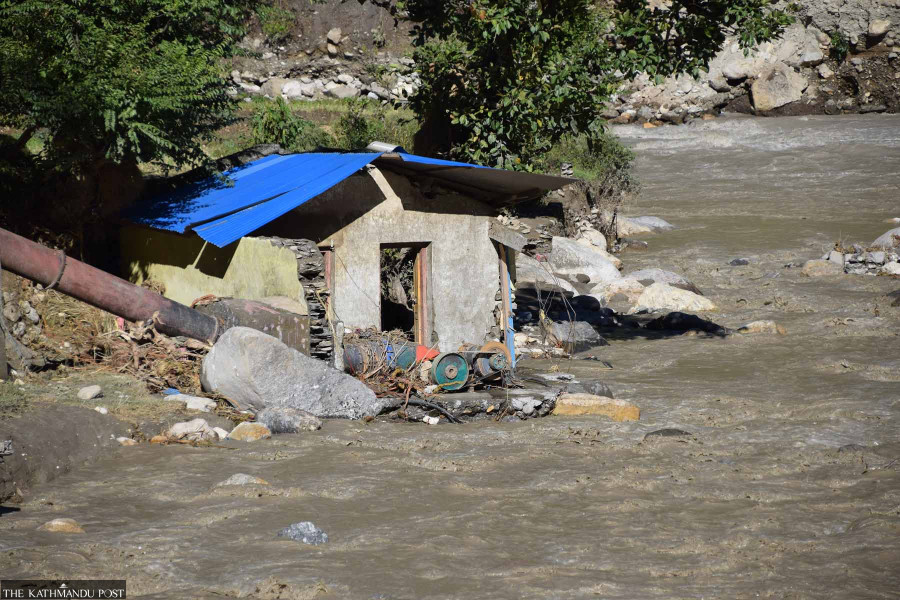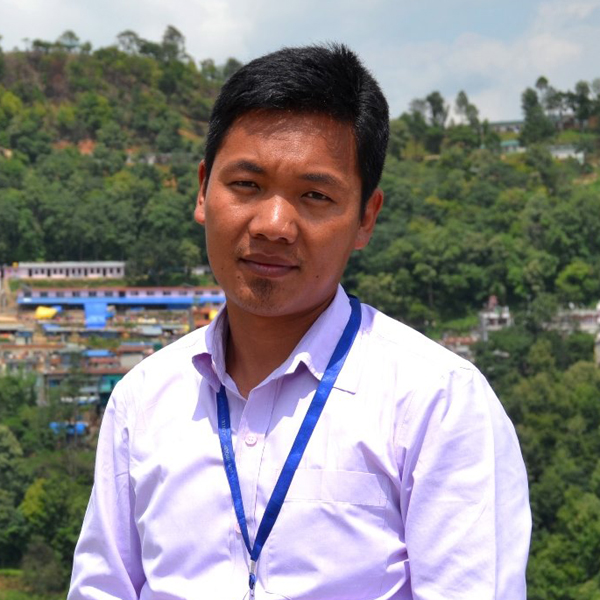Money
Micro hydros face doubtful future as national grid reaches rural homes
Dozens of massive hydroelectric projects are being built every year, and the little guys may soon become irrelevant.
Kumbha Raj Rai, Tika Prasad Bhatta & Prakash Baral
Micro hydropower projects, which transformed life in Nepal's hills and mountains by lighting up rural areas and allowing villagers to set up rice and oil mills, now face an uncertain future with the advent of large hydropower plants.
Dozens of massive hydroelectric projects are being built every year to harness water resources to the maximum, and the little guys may soon become irrelevant.
Nepal launched the era of micro hydropower to generate electricity in 1911 with the Pharping plant which had an installed capacity of 500 kilowatts. It was followed by Sundarijal and Panauti in 1936 and 1965 respectively.
During the 1960s, locally developed micro hydro turbines started replacing diesel engines mainly for agro-processing. Micro hydros proliferated in the 1980s and 1990s as the government began to provide subsidies.
“Investments in micro hydel have gone to waste as now almost all villages are connected to the national grid,” said Pradeep Sunuwar, a local of Khijidemba Rural Municipality in Okhaldhunga.
“Besides making financial contributions, locals have also donated labour in the projects,” he said. “That’s not worth anything now. At the least, the electricity generated by micro hydel projects should be connected to the national grid."
In many places, the equipment of micro hydro project lie in dilapidated conditions.
Natural disasters such as earthquakes, floods and landslides have also damaged the infrastructure.
The millions of rupees invested in the projects have gone to waste as the electric poles, wires, powerhouses, canals and other infrastructures have been left unused.
In Okhaldhunga district alone, more than 50 micro hydro projects, ranging in capacity from 5 to 100 kilowatts, were developed. But only 30 are in operation now.
Around Rs1 billion was invested in the projects which have a combined capacity of 1 megawatt.
Pratish Dhakal, chief of the Okhaldhunga distribution section of the Nepal Electricity Authority, said they had been using the infrastructure of micro hydros which fit their needs.
As the authority is focused on the development of big projects, connecting micro hydels to the national grid has not been a priority, say insiders.
Nepal has aimed for 100 percent electricity access by 2024.
Electricity had reached 92.52 percent of the country's population as of the last fiscal year ended mid-July.
According to the power utility, 10 districts were added to the national grid in the last fiscal year. The number of fully electrified districts has now reached 42.
“As the rural municipality has been rapidly connecting villages to the national grid, there is uncertainty over the investment made in micro hydels,” said Ram Kumar Sunuwar, ward chair of Khijidemba-5 in Okhaldhunga.
In Ilam, locals of Sandakpur Rural Municipality-5 developed a micro hydropower project by taking a loan and keeping their land as collateral. But the project started having issues within a few years of its operation.
“Though around 80 families still use the power generated by the project, maintenance costs have troubled locals,” said Dhal Bahadur Gurung, ward chair of the rural municipality.
In Khotang district, around one and a half dozen micro hydropower projects are still in operation.
At Sawakatahare in Khotehang Rural Municipality-3, the power generated by a 43 kilowatt project is used by 270 households and four mills, according to local Shyam Raj Rai.
"A 10 kilowatt project at Jante Dhunge Rural Municipality closed down after a landslide buried its powerhouse," said Devendra Shrestha, ward chair of Khotehang Rural Municipality.
An 18 kilowatt project using the water of the Chhimawa River at Kahule in Jante Dhunga-3 has remained closed for the past seven years.
The project, which came into operation 15 years ago, was supplying power to 140 families. While the project’s canal has been blocked by the landslide, the machinery has been lost or destroyed over the years.
Around 180 families have been relying on solar and battery power after a 19 kilowatt project at Jante Dhunga-3, which was constructed at a cost of Rs7 million, shut down.
Dozens of micro hydel projects in Ramechhap and Dhading districts have closed, leaving the equipment to decay and disintegrate.
The project at Bijulikot in Ramechhap made with an investment of Rs25 million was shut down by the 2015 earthquake. Around 530 houses depended on the plant for power.
“We had not even cleared the loan taken for its construction when the earthquake destroyed it,” said Krishna Bahadur Mahat, former chairman of the Bijuliot village development committee.
“We are not able to revive the project due to the cost issue. Since the national transmission line has reached the village, the infrastructure of the micro hydel project has been left unused,” Mahat added. “We plan to auction off the equipment and divide the money among the investors.”
A 16 kilowatt hydel project in Bijulikot, which supplied power to 130 families, has a similar story.
“The project has remained idle after local houses were connected to the national grid, which is cheaper and more reliable,” said local Tara Bahadur Moktan.
Though a micro hydro developed by British Welfare at Gupteshwor in northern Ramechhap, which is yet to be connected to the national grid, is still working, locals say enthusiasm for micro hydros has declined in recent years.
The construction of a 1 kilowatt micro hydropower scheme in Dhading’s Tripura Sundari Rural Municipality, Mulpani around 28 years ago lit up 17 houses and supplied power to run a mill. Not only that, the Seureni project’s canal supplied water to irrigate nearby farms.
Locals donated labour besides pooling Rs217,000 for its construction. But the project shut down after a decade when the national transmission line reached the village.
“Around 20 percent of the micro hydels built in the district are not in operation,” said Sher Bahadur Bhandari, coordinator of Apasi Bikas, an agency which works in the micro hydel sector.
The Shyaure Bhumi micro hydropower project in Shivapuri Rural Municipality in Nuwakot has been connected to the national grid.
Built more than two decades ago by local resident Sudarshan Budhathoki with an investment of Rs200,000 and assistance from the villagers, the project supplied power to around 120 houses.
But locals stopped using it around nine years ago when the village was lit up by the power coming from the national grid.
Budhathoki struggled for two years to get the electricity produced by the project connected to the national grid.
“A power purchase agreement was signed between the project and the Nepal Electricity Authority in February 2016,” said Budhathoki. “In January 2018, the project was connected to the national grid.”
There are 401 micro and small hydel projects in Gandaki province.
Most of the villagers in Parbat, Lamjung and Gorkha have not used electricity produced by the micro hydels after the villages were connected to the national grid.
In Baglung, micro hydels are still in operation in villages yet to be connected to the national grid.
Parts of western Baglung are still dependent on micro hydels as they have not been connected to the national grid. There are around 150 projects which produce 200 megawatts.
Though micro hydels are being closed down one after another in Karnali, locals say some of them can be repaired.
“A huge investment is not required to repair the Upper Rumkhola hydel project at Bhagawatimai Rural Municipality-3 which has been damaged by a landslide,” said local Bud Bahadur Khadka.
“The project has not been in operation for the past six years. By hesitating to spend Rs100,000 or Rs200,000, a plant worth Rs10 million has been lying in ruins.”
Locals in Kalikot say leaders have prioritised expansion of the national grid over the continuation of micro hydels.
Around 506 families in Mugu have been living in darkness after the closure of 19 micro hydels in the district. Only eight villages in the district have been using the power from such projects.
“We have gone back to traditional oil lamps after the micro hydels stopped operating,” said Roshan Shahi, former sub-engineer at the then district development committee. “We have to make an hour-long journey to the nearest village to recharge our mobile phones.”
The situation is the same in Sudurpaschim province. More than 40 micro hydel projects have stopped working in Bajhang district alone.
(Raj Bahadur Shahi in Mugu and Basanta Pratap Singh in Bajhang contributed reporting.)




 9.12°C Kathmandu
9.12°C Kathmandu
 (1).jpg)
.jpg)















